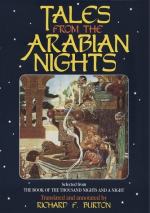[Section iii.]—This is one of the most important in the book, in which extracts from Galland’s Diary of 1709 are quoted, shewing that he was then in constant communication with a Christian Maronite of Aleppo, named Hanna (Jean), who was brought to Paris by the traveller Paul Lucas, and who related stories to Galland, of which the latter took copious notes, and most of which he worked up into the later volumes of his “Mille et une Nuit” (sic). Among these were 193, 194a, 194b, 59, 197, 198, 174, 195, 194c, 196. The following tales he did not use: An Arab story of two cousins, Camar eddin and Bedr el Bodour; the Golden City (another version of the story of the Three Princes, in No. 198, combined with the story of the woman who slew pretenders who were unable to solve a riddle); The Three Princes, the Genius Morhagian, and his Daughters; and the story of the seller of ptisanne (or diet-drinks) and his son Hassan.
Further extracts from Galland’s Diary are added, extending from the time of Hanna’s departure from Paris between June and October, 1709, and the completion of the 12th volume of the Mille et une Nuit in 1712. These relate to the gradual progress of the work; and to business in connection with it; and Hanna’s name is occasionally mentioned.
Hanna supplied Galland with a written version of No. 193, and probably of 194 a-c; (i.e. most of the tales in vol. 9 and 10); but the tales in vols. 11 and 12 were apparently edited by Galland from his notes and recollections of Hanna’s narrations. These are Nos. 195, 196, 59, 197 and 198. M. Zotenberg concludes that Hanna possessed a Ms. containing all these tales, part of which he copied for Galland, and that this copy, like several other important volumes which Galland is known or believed to have possessed, was lost. M. Zotenberg thinks that we may expect to meet with most of Hanna’s tales either in other copies of the Nights, or in some other collection of the same kind. The latter supposition appears to me to be by far the most probable.
[Section iv.]—M. Zotenberg proceeds to give an account of one or two very important MSS. of the Nights in the Bibliotheque Nationale. One of these is a Ms. which belonged to the elder Caussin, and was carefully copied by Michael Sabbagh from a Ms. of Baghdad. Prof. Fleischer, who examined it, states (Journal Asiatique, 1827, t. Ii., p. 221) that it follows the text of Habicht, but in a more developed form. M. Zotenberg copies a note at the end, finishing up with the word “Kabikaj” thrice repeated. This, he explains, “est le nom du genie prepose au regne des insectes. Les scribes, parfois, l’invoquent pour preserver leurs manuscrits de l’atteinte de vers.”




